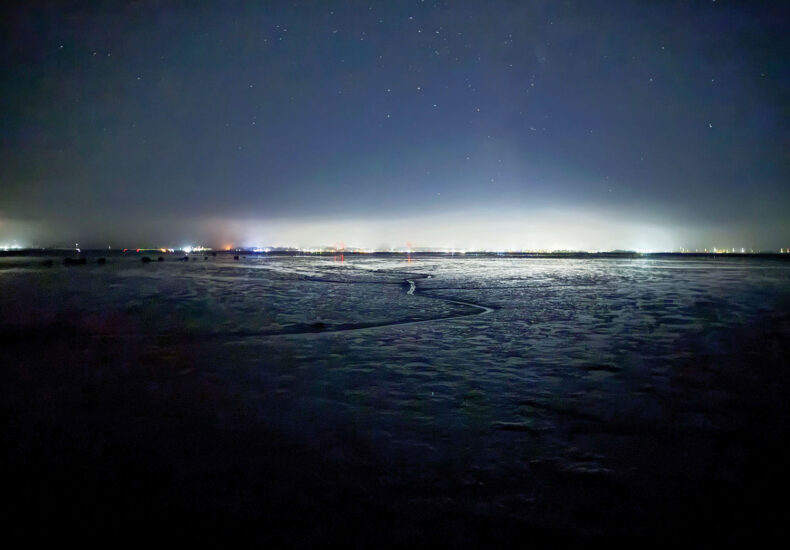
Protecting the Night
Humboldt’s New Lighting Ordinance Shines a Light on Dark Sky Preservation
Mark Wilson’s home in McKinleyville was surrounded by farm fields in the ’90s, making his backyard a prime spot for stargazing. By taking a few steps out of his house, he could bear witness to the depths of the night sky and all its planets and constellations.
Over the years, the area developed and fields were replaced by homes and businesses. The light from these buildings overwhelmed the view of the stars and left only larger celestial sights visible. Wilson says he hasn’t gone stargazing in his backyard in years.
“Some of the light’s coming from light sources nearby, but it’s enough to make it not worth my time to go out there with my binoculars,” he says.
As vice president of Astronomers of Humboldt, Wilson represented one of several groups supporting the lighting regulations for unincorporated portions of the county approved by the board of supervisors in a 3-2 vote on Aug. 19. Now covering inland areas, the guidelines were influenced by recommendations from DarkSky International, an advocacy group dedicated to combating light pollution.
An accompanying coastal version still needs approval from the California Coastal Commission to go into effect.
What the Dark Sky Ordinance Entails
Under the dark sky ordinance, new exterior lights in residential areas can be a maximum of 1100 lumens—a brightness measure equivalent to a 75-watt bulb—and 3200 lumens in commercial zones. It also adds restrictions on light spillage onto other properties and motion sensor lights.
“I think it’s remarkable that we didn’t already have a lighting ordinance,” said Fourth District Supervisor Natalie Arroyo, who voted in favor of the ordinance. “It’s very commonplace for people to have a lighting ordinance and to have rules about lighting, so I’m frankly surprised that anyone voted against it. But I think we’re coming up to speed with our peers in other counties by having a lighting ordinance.”
Lighting ordinances are generally passed to protect the health of wildlife and residents, preserve views of the night sky, and prevent the waste of energy.
Light Pollution’s Impact on Wildlife
Humboldt County lies on a major migratory path called the Pacific Flyway, which millions of birds use to fly between North and South America each year. Matthew Johnson, a Cal Poly Humboldt professor specializing in ornithology, explains that since birds primarily use the stars as a directional guide, light pollution can cause disorientation that alters their migration patterns, sometimes preventing them from reaching their destinations.
“Spotlights, in particular, can confuse birds to the point where they fly in circles until they die from exhaustion,” Johnson said.
“They are attracted to lights, and so they’re using celestial cues,” Johnson added. “In the biggest, broadest sense, the lights are triggering some of those behavioral responses. I think in the case of the spotlights, they kind of get in that tunnel of light and going out of it just looks like the wrong way to go.”
According to outdoor educator Jessy van Royen, each population area creates its own cascading emanations, resulting in fragmentation of natural environments including national forests, which can confuse wildlife.
“They kind of make this connected blob of sky glows,” van Royen said. “If you think about it, if you were a bird trying to fly through the dark areas, now those are disconnected from each other. And they have to fly through this, but then, when they fly through the brighter light, they might get disoriented.”
It’s not just birds affected. From sea turtles and bats to insects and plants, light pollution can negatively affect a vast array of flora and fauna that rely on light or darkness for physiological and directional cues.
“You don’t think about it when you go to the beach in the evening and there’s lights on the street nearby, but those lights are spilling onto the water,” van Royen said. “It changes the behaviors of aquatic animals and can really affect their survival rates.”
Shining a Light on Human Well-Being
Van Royen has been reviewing studies on light pollution to educate local residents on the importance of regulating both the brightness and temperature of lighting. Humboldt Waterkeeper is collaborating with DarkSky International and area businesses to raise awareness on these findings.
“Because it can disrupt our circadian rhythms, it kind of throws off our natural cycles of when we’re eating and sleeping,” van Royen explained. “And that can have an effect on our health by contributing to insomnia, depression, obesity—we can lose our night vision.”
She adds that when a person looks at a bright light, it becomes more difficult to see things outside the light’s range. In nighttime work situations like construction, this can have dangerous consequences.
Van Royen pointed to case studies where DarkSky International collaborated on projects worldwide to mitigate the effects of light pollution. For example, in the Amazon, they worked with the owner of an industrialized site in the middle of the forest that was so brightly lit it could be seen from the next town over.
“They implemented their recommendations and started having fewer accidents on site, like workers running into each other with forklifts,” van Royen said.
There’s also a simple benefit to preserving dark skies—the joy of stargazing. Wilson, who has participated in and hosted many astronomy events, says he feels a connection to history through viewing the night sky. Every community has its own interpretations and stories behind constellations, and modern technology helps us learn even more.
“Recently, I was in France to see the cave paintings from the Ice Age and at the end of the Ice Age,” Wilson said. “And I think about those people—they had pretty dark skies. That’s why they like to go back in those caves. But I just imagine the sight they had in looking at the night sky. It had to be just awe-inspiring.”
Recommendations and Hope for the Future
Regarding wildlife protection, Johnson recommends shielding brighter bulbs to keep outside lights projecting downward onto the ground and limiting lighting on taller buildings to prevent bird collisions.
He hopes that as people adjust their lighting, they will see benefits for themselves as much as for the birds living in or passing through Humboldt.
“If their electricity bill goes down a little bit, or they realize, ‘Oh, there wasn’t the crime risk we thought there was,’ or ‘maybe this even reduced the crime risk,’” Johnson said. “Like any change, often there’s some resistance. But once you try, you think, ‘Oh, not only is this just OK, maybe it’s actually better.’”
Wilson hopes the new ordinance will be the start of a more visually dynamic night sky for the county to enjoy and learn from.
“It would be nice if I could go back into my backyard and spend more time at night, personally,” Wilson said. “But overall, for the Humboldt community, it’ll make going out at night a little more pleasant.”
Griffin Mancuso (he/him) is a freelance journalist based in Eureka. He is passionate about uplifting the stories of local communities and wildlife education and preservation. More of his work can be found at griffinmancuso.wordpress.com.
https://www.northcoastjournal.com/news-2/protecting-the-night/
You may also like
You may be interested
Clovis Police now using drones as ‘first responders’
**Clovis Police Department Introduces Drone First Responders to Enhance Public...
The incredible transformation of Elastigirl on screen
**The Incredible Transformation of Elastigirl on Screen** *By Vinita Jain...
‘I respect all religions’: CJI after idol remarks spark row
By Chanshimla Varah | Sep 18, 2025, 04:22 PM **Chief...
 The New York Times
The New York Times
- Fire at a Nightclub in Goa, India, Kills at Least 25 2025 年 12 月 7 日 Pragati K.B. and Jin Yu Young
- Everyone Wants High-Quality Clothes. That’s Become Its Own Trend. 2025 年 12 月 7 日 Isabel Cristo
- Judge Halts Justice Dept. Effort to Seek New Comey Indictment 2025 年 12 月 7 日 Alan Feuer
- Australia’s Social Media Ban for Under-16s Is Coming. The Teenagers Are Skeptical. 2025 年 12 月 7 日 Victoria Kim and Matthew Abbott
- How Australia’s Social Media Ban for Children Will Work 2025 年 12 月 7 日 Victoria Kim
- In Honduras, Some Voters Were Swayed by Trump, Others Angered 2025 年 12 月 7 日 James Wagner and Jeff Ernst
- Francis Ford Coppola’s F.P. Journe Sells for $11 Million at Auction 2025 年 12 月 7 日 Jacob Bernstein
- Florida Man Charged in Murder of Woman Found Near Gilgo Beach 2025 年 12 月 6 日 Maia Coleman
- Battlefield Picture Worsening for Ukraine as Trump Pushes Peace Plan 2025 年 12 月 6 日 Cassandra Vinograd, Oleksandr Chubko and Maria Varenikova
- Could President Trump Bring Japan’s Tiny Cars to America? Not So Fast. 2025 年 12 月 6 日 Hiroko Tabuchi



Leave a Reply